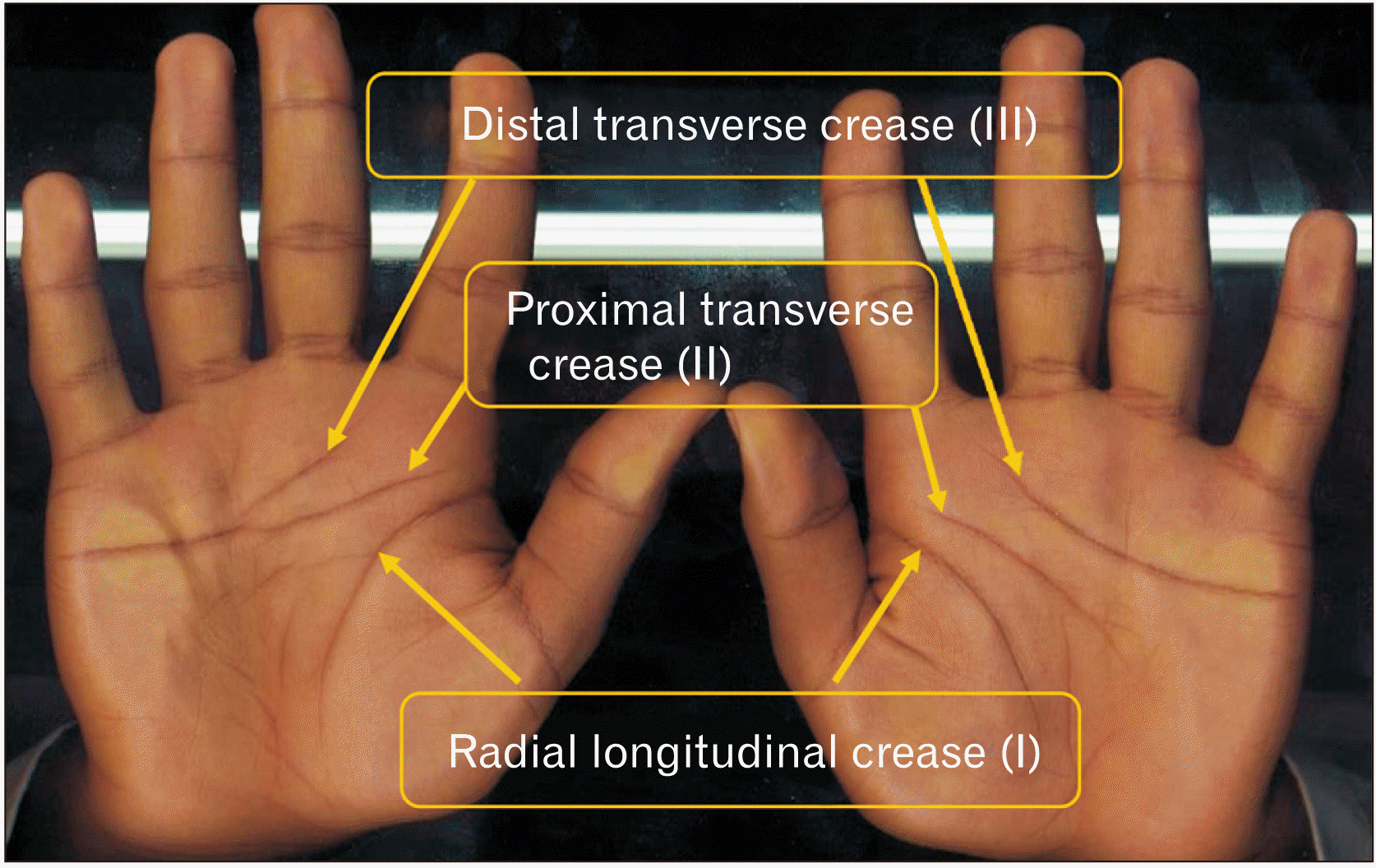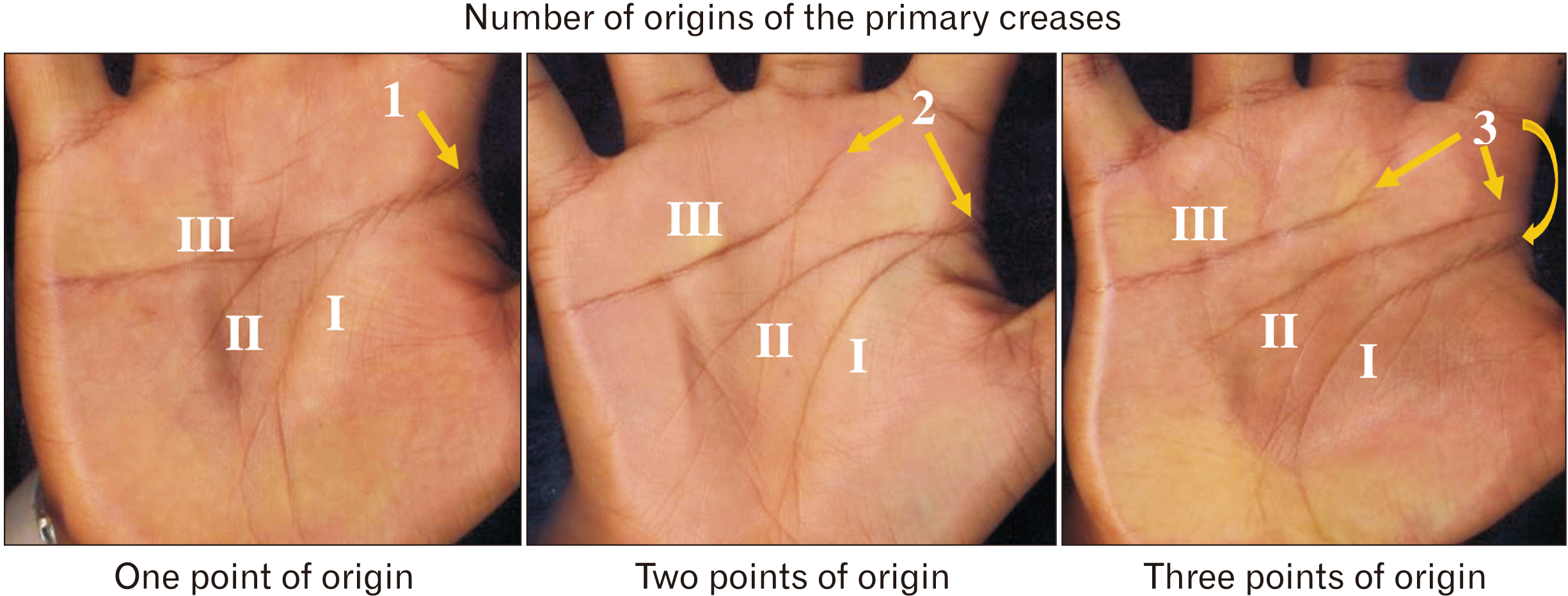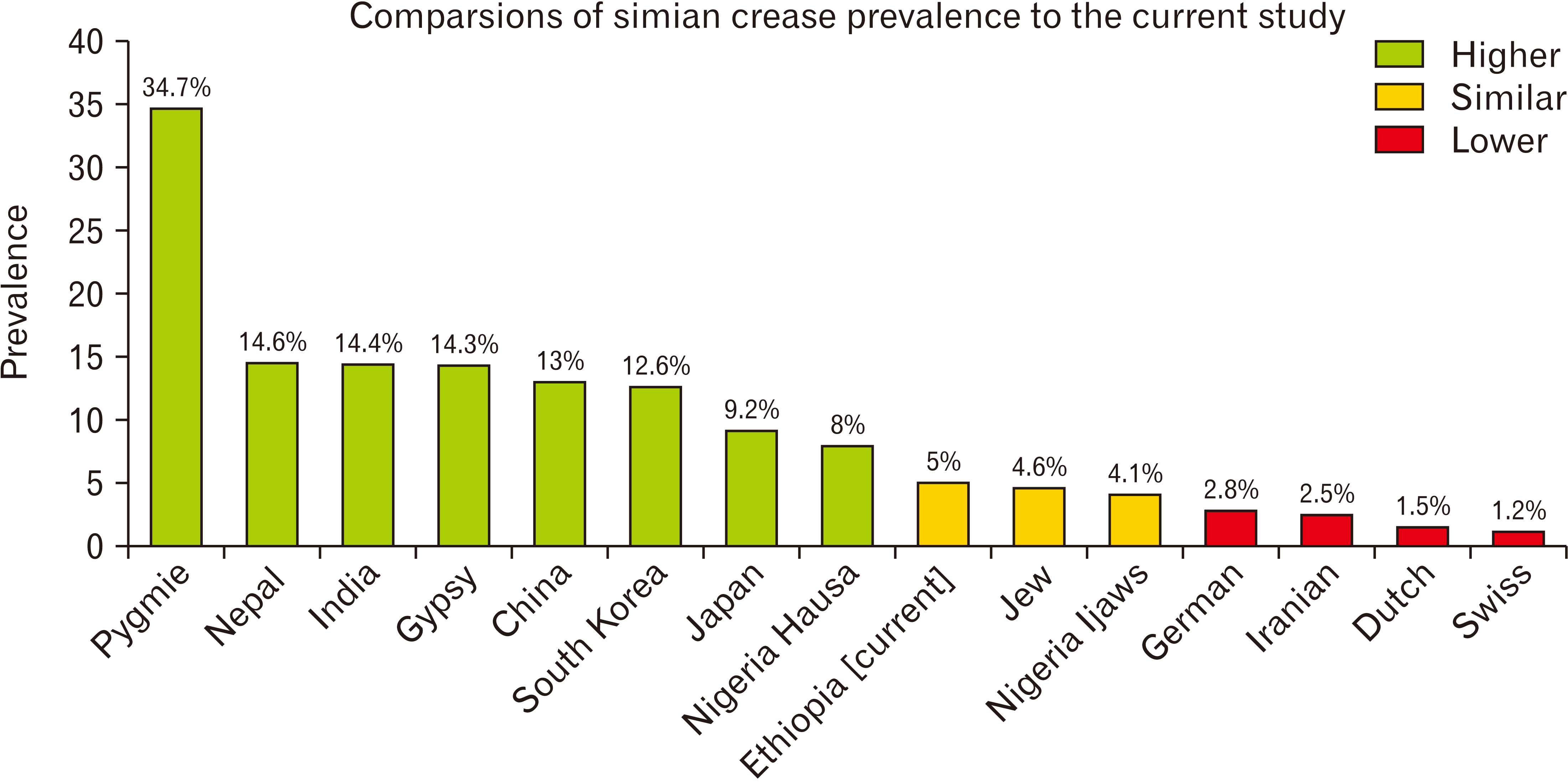Introduction
Palmar creases are unique, genetically controlled morphological variables and surface registrations of the mobility parts of the hand [
1]. It marks the site of the skin joint brought into action by the underlying bony joints [
1-
3]. They are important tools that have been used in the areas of personal identification, criminal investigation, as well as a medical diagnosis of several congenital diseases [
4-
6]. Radial longitudinal creases (I), proximal transverse creases (II), and distal transverse creases (III) [
7-
9] are major palmar creases [
8]. Based on the relationship between the two transverse creases namely the proximal transverse crease and distal transverse crease, there are four palmar crease pattern types [
7]. These are normal crease, simian crease, sydney crease, and suwon crease [
7,
8]. Simian, sydney, and suwon creases are considered as variant types of palmar creases and are mainly associated with chromosomal abnormalities and congenital diseases [
8-
10]. Palmar crease patterns are genetically determined variables, which differ from population to population [
5,
8,
11] and help to discover the anthropologic characteristics of a population [
5-
7]. Variant types of palmar crease patterns such as Simian and Sydney crease formation are greatly influenced by fetal developmental abnormalities like premature and small for gestational age infants [
12]. The variant types of palmar crease patterns have been employed as a diagnostic tool for several diseases with chromosomal abnormalities and strong hereditary backgrounds [
2,
8,
13,
14]. The presence of Sydney crease is indicative of certain health conditions including down’s syndrome, delayed development and learning difficulties [
2], Alzheimers’, leukemia [
13], and congenital rubella [
14]. Scientific evidence suggested that palm crease patterns are closely associated with brain functions and intelligence [
4,
15]. Variant types of palmar creases are also employed as predictive indices in apparently normal persons in whom cryptic damage may manifest later [
2]. Thus, knowledge about the prevalence of variant crease is helpful to assess the magnitude of the population which are at risk to develop the disease of chromosomal abnormalities and congenital disease [
9,
10]. The presence of these variant palmar creases patterns do not necessarily always signify abnormality in genetic property or other anthropologic characteristics as it has been observed in some normal individuals and, some were exceptionally intelligent [
2]. Palmar crease patterns have significantly associated with sex [
8,
9], ethnicities [
11,
12,
14,
16], symmetries between two palms [
4,
8], handedness [
8], body sides [
8] and points of origin of the primary palmar crease. Since palmar crease study is helpful in revealing the anthropologic characteristics of the populations, it is better to study in countries that have different ethnic groups like Ethiopia. Moreover, Ethiopia is the origin of mankind and a resourceful country in anthropologic data. Therefore this study can give a clue of Ethiopian palmar crease patterns based on their ethnicity for anthropological studies. Most of the studies done in this thematic area didn’t consider the methodological issue including sample selection and sample size calculation but, this study takes into consideration of this issue. This study aimed in revealing the anthropological characteristics as well as contributing to the diagnosing of congenital disease of Ethiopian people.
Materials and Methods
Study area and period
An institution-based cross-sectional study was conducted from January to February 2019, at the University of Gondar, northwest Ethiopia. The University of Gondar is found in Gondar city which is located 739 km from Addis Ababa, the capital city of Ethiopia. It is one of the former universities in Ethiopia and has currently five campuses. In the 2018/2019 academic year, 41,730 students were enrolled in 56 undergraduate programs.
Population
All regular undergraduate students at the University of Gondar who were attending class in the 2018/2019 academic year were our source of population. Whereas regular undergraduate students at the University of Gondar who were enrolled in the selected departments in the 2018/2019 academic year were our study population. Students with an injury to their palms and deformed hands were excluded from the analysis.
Sample size determination and sampling procedures
Single population proportion formula using P-value of 50%, 95% confidence interval (CI), 5% margin of error, and 10% non-response rate were used to calculate sample size. Since the sampling technique was multi-stage sampling, design effect size two was used. Then the final sample size were 845. From the five campuses of the University of Gondar, Atse Theodros II campus and the College of Medicine and Health Science campus (CMHS) were selected by simple random sampling. Among the total of 51 batches (12 departments) of the College of Medicine and Health Science campus, 9 batches (from eight departments) were selected. From the total 54 batches (15 departments) of the Atse Theodros II campus, 10 batches (from 10 departments) were selected. Proportional allocation formula were used to adjust the sample size needed for each selected campus. Then study subjects selection interval (k) was determined by deviding the number of all students who were enrolled in selected batches to sample size. The 1st student was selected randomly and then, the other students were selected using a systematic random sampling method in every kth interval until the required sample size was achieved.
Study variables
The dependent variable was the types of the palmar crease, which has four categories: Normal, Simian, Sydney, and Suwon creases. The normal crease pattern is formed when proximal transverse creases (II) and distal transverse crease (III) do not meet and no crease line transversely crosses the full palms [
7,
8]. Where as simian, sydney, and suwon creases were considered as a variant types of creases. Simian crease pattern is so named because it resembles the usual condition of non-human simians (primates) [
7,
17]. The sydney crease is so named, because it was first described in Sydney, Australia, 1968 [
14,
18,
19]. In addition some writers considered suwon crease as a “cousin” of the sydney line [
14] and it is so named because it was first described in 2010, Suwon, Korea [
7]. The patterns of these crease type are well expressed in
Table 1. The independent variables this study were sex, ethnicity, bodyside, handedness, symmetry (unilateral/bilateral occurrences of patterns), and points of origin of the primary palmar crease (
Table 1).
Data collection tools and procedures
Three methods of data collection were used i.e., structured self-administered questionnaires which were used to assess the sociodemographic characteristics and handedness of students; Scanning of palms using “HP Deskjet digital scanner, 2700 model (Scanner Supplier & Manufacture in China, Guangdong, China)” which was connected to a laptop computer (
Fig. 1); and observational checklist which had been filled after observing the palmar images. Students were asked to fill in all the necessary information in self-administered structured questionnaires.
The scanned palmar images were observed and the checklists were filled to assess palmar crease pattern, the symmetry between the two palms, and the number of radial base creases of primary palmar creases with the help of the method presented by Park et al. [
7], 2010 and Bali and Chaube [
20] 1971. Handedness was assessed by asking students ten activities on which hand they perform using self-administered structured questionnaires and the answers were fed to the user-friendly online handedness assessment tool [
21] which was derived from the Edinburgh Handed Inventory formula [
22].
Data processing and analysis
The collected data were checked for completeness, accuracy, and clarity before analysis. Data were entered to Epi info version 7.2.2.2. (Centers for Disease Control and Prevention, Atlanta, GA, USA) and exported to Statistical Package for Social Science (SPSS) version 20 software (IBM Corp., Armonk, NY, USA) to be cleaned and analyzed. Chi-square test, bivariable and multivariable multinomial logistic regression analyses were done. The crude odds ratio (COR) were assessed and variables with P-value ≤0.2 were selected for the adjusted odds ratio (AOR). Associations between dependent and independent variables were declared using AORs and 95% CI with P-value of <0.05. The goodness of fit test and multicollinearity were checked before doing any statistical analysis and the model was good fit and no have multicollinearity between variables.
Ethical consideration
Ethical clearance was obtained from the University of Gondar’s ethical review committee (no. 1415/2011). The study was conducted following the approval of the committee and after obtaining the ethical letter. To ensure confidentiality of data, study subjects were identified using codes.
Discussion
Palm crease patterns are helpful in revealing the anthropologic characteristics of the populations [
5,
12]. It also indicates the possibility of chromosomal aberrations, intrauterine toxin exposure, fetal alcoholic syndrome, mental retardation, neoplasia, and other diseases [
2,
7,
12,
23]. Palmar crease patterns have practical use because they can be analyzed quickly without invasive procedures, physical pain, high costs, or age considerations [
12].
In this study, the prevalence of the normal palmar crease was 90.8% (95% CI: 89.5, 92.1). It was lower than a study conducted in Nigeria (93.1%) [
9] but higher than other studies conducted in Nigeria (89%) [
24], Suwon, Korea (84.4%) [
7], and central India (79.6%) [
8] (
Table 4). The difference might be due to differences in the study population, study design, and genetic differences between populations [
8].
In the current study, the prevalence of the simian crease pattern was 5% (95% CI: 4.1, 5.9). It was comparatively similar to studies conducted in Nigerian (4.1%) and Jewish (4.6%) [
2,
8], but lower than other studies conducted in a different part of the world [
7,
8,
11,
13,
14,
24]. On the other side, the finding of this study was higher than studies conducted in Japanese (4%), Swiss (1.2%), and Germans (2.8%) [
2,
8,
9] (
Fig. 4). This might be associated with as palmar creases are different among races and ethnicities [
25]. The prevalence of the simian crease pattern increased as we move from the Caucasians to the Orients [
2]. Studies showed that palmar creases are different among ethnicities independent of their association with a given disorder [
25]. This discrepancy might be explained by ethnohistoric and geographic variations between different groups of people [
12], the study design used, and classification systems of palmar crease patterns.
The prevalence of the suwon crease pattern in this study was 2.3% (95% CI: 1.7, 3.1), which was similar to the studies conducted in Nigeria [
24] and central India [
8]. It was higher than a report from Suwon, Korea (
Table 4) [
7]. This might be due to that, the Suwon, Korean report was the first report to identify the Suwon crease pattern type and had limitations to clearly define its subtypes [
7]. In this study, the sydney crease pattern was the least prevalent type (1.92%) (95% CI: 1.3, 2.6). It was comparatively similar to the two studies conducted among the Hausa ethnic group of Nigeria (1.85%) [
9] and (1.3%) [
24], and Suwon, Korea (2.5%) [
7]. It was higher than the study conducted among the Ijaws ethnic group of Nigerian (0.19%) [
2] but lower than studies conducted in Sydney Australia (9%) [
19], and Central Indian (3.6%) [
8] (
Table 4). This difference might be explained by the ethnic variation of the Sydney crease between black and white populations [
12]. Generally, the discrepancy in the prevalence of all types of palmar crease can be explained by ethnohistoric and geographic variations between different human populations [
8], meanwhile, dermatoglyphic polymorphism results from the cooperation of genetic, ethnohistoric, and environmental factors [
12]. Due to this, palmar crease patterns are valuable in exploring inter-ethnic variability in anthropology studies and diagnostic relevance [
2,
12].
In this study, being male was nearly two times more likely to have a simian crease than a Normal crease. This was in line with a study conducted in India [
8] and a study conducted among Korean and Iran populations also revealed significantly higher in males [
7,
16]. A similar report was found among different studies [
2,
11,
24]. In the present study, males had higher odds of sydney crease pattern than normal crease pattern. It was supported by studies conducted in Nigeria, and Korea [
2,
7,
24], but on the contrary study in Central India [
8]. This may be due to that later studies included a wide range of age groups [
8].
In our study, students from the Gurage ethnic group were more likely to have simian crease. It is supported by another study that indicates variation in the prevalence of palmar crease across different ethnic groups [
11]. This variation across different ethnic groups can be explained by genetically inherited and evidenced by parents with Simian crease having more children with this trait than offspring of parents without this [
13,
20]. These differences are physical anthropological variations and normal occurrence amongst diverse human populations, but not related to chromosomal abrasion or other disease entities [
2].
In this study, all variant types of the palmar crease (semian, sydney and suwon) had an association with one point of origin of the primary palmar creases. It is supported by a study conducted in the United States of America [
25]. Individuals who have a single point of origin of the primary palmar crease were more likely to have Simian, Sydney and Suwon crease patterns than normal crease patterns [
25].
Handedness was also another important determining factor for the occurrence of simian and suwon crease patterns in this study. Right-handed individuals were less likely to have simian crease and suwon crease patterns than normal crease patterns. In contrast to this finding, a study done in India showed that Simian crease had a statistically significant association with right-handedness, and suwon crease had no significant relation with handedness [
8]. A study conducted in Nigeria also showed, no association between handedness with all types of variant crease patterns [
24]. This difference might be due to different handedness assessment methods, tools and data analyzing models. In this study, the sydney crease pattern had no significant relation with handedness, which was in line with a study conducted in India [
8] and Nigeria [
24].
In this study, the prevalence of normal and simian crease patterns were slightly more common in right palms, however, the suwon crease was slightly more prevalent in left palms. Sydney crease had an equal distribution in both palms. But all types of palmar crease patterns hadn’t statistically significant association to bodyside (
P>0.05). This was supported by different studies conducted elsewhere [
2,
8,
9,
16,
23].
Generally in this study, the normal palmar crease was the most prevalent. The common type among the variant palmar creases was the simian crease followed by the suwon crease and sydney crease. Palmar crease pattern is affected by different factors such as sex, ethnicity, handedness, and points of origin of the primary palmar crease. This study will be used as a baseline data for further studies of palmar crease types in all regions of Ethiopia with large sample size.





 PDF
PDF Citation
Citation Print
Print






 XML Download
XML Download